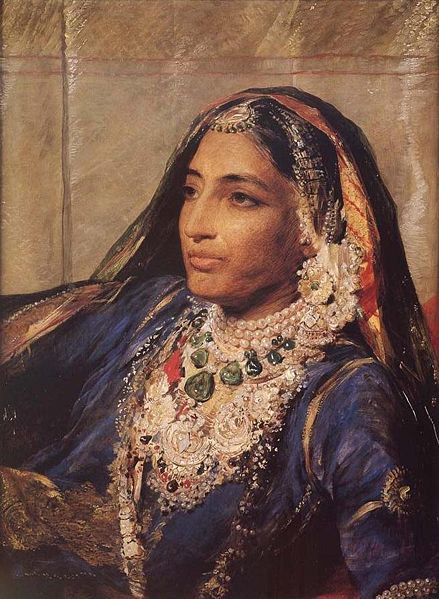
New info on Sikh Maharani, Jind Kaur, uncovered
This week, Peter Bance published “Sovereign, Squire and Rebel: Maharajah Duleep Singh and the Heirs of a Lost Kingdom.” It includes some little known and interesting information on Rani Jindan- the youngest of Maharaja  Ranjit Singh’s wives. While the tale of her son, Duleep Singh, has been well documented, less has been known about Rani Jindan.
Ranjit Singh’s wives. While the tale of her son, Duleep Singh, has been well documented, less has been known about Rani Jindan.
While researching a tome on the Duleep Singh family, which lived in exile on a sprawling country estate near Thetford, Norfolk, Mr Bance stumbled upon the gravestone of Jind Kaur in the catacombs of the Kensal Green Dissenters’ Chapel. Historians had assumed that the Maharani’s cremation occurred in India but here was a simple white marble tombstone in London with her name on it. [link]
So who was Rani Jind Kaur? Some things were previously known- that after the death of her husband, she became the Regent (acting head of state because the ruler is a minor) for her son, Duleep Singh.
To say that Jind Kaur was a thorn in the side of the East India Company would be an understatement. She was born into humble origins, the daughter of the Royal Kennel Keeper at the Sikh court in Lahore, but she was ravishingly beautiful and soon caught the attention of the Punjab’s greatest ruler, the one-eyed Ranjit Singh.
Having kept the British at bay for decades, Ranjit’s empire began to crumble with his death in 1839. Following a series of bloody succession battles, Jind emerged as regent for Duleep who was less than a year old when his father died. [link]
Rani Jindan was instrumental in organizing Sikh resistance to the British in the First and Second Anglo-Sikh wars.
Concerned about the instability (and attracted to the kingdom’s fabulous wealth) Britain began preparing to take the Punjab, goading the Sikh armies into two wars that eventually led to the disappearance of an indigenous Asian empire that stretched from the Khyber Pass to Kashmir.
Jind was instrumental in organising the Sikh resistance, rallying her generals to return to battle and plotting rebellion once the British finally took over the Punjab in 1849. [link]
She was separated from her son, the 11 year old Duleep Singh, to prevent her from further influencing him, and eventually imprisoned in Forth Chunar in Uttar Pradesh.
To halt her influence on the young Duleep, the Punjab’s new colonial masters dragged the Queen away from her son and imprisoned her. The British press began a smear campaign against the Maharani, labelling her the “Messalina of the Punjab”, portraying her as a licentious seductress who was too rebellious to control. [link]
But Rani Jindan proved herself to be irrepressable. She escaped from her jailers, dressed as a maid servant, and trekked 800 miles to Kathmandu. Where are the movies about this amazing life?
In a final act of defiance Jind Kaur escaped her jailers dressed as a slave girl and trekked 800 miles to Nepal where she was given begrudging asylum and a place in Sikh folklore as a national hero. [link]
Meanwhile, her son Duleep Singh had grown up as an Englishman.
Adopted by a dour colonial surgeon, that son, Duleep Singh, swiftly shed his Punjabi customs, converted to Christianity and moved to England to live the life of a respectable country squire, shooting grouse on his estate and hosting decadent parties for Britain’s Victorian elite. [link]
Until, that is, he was reunited with his mother.
She was only allowed to see her son 13 years later when he returned to Kolkata for a tiger-hunting trip. Duleep asked to bring his mother from Kolkata to England. The British Government decided the last Queen of the Punjab no longer posed a threat and gave him permission. [link]
Soon after their reunion, Duleep Singh unsuccessfully tried to persuade the Tsar of Russia to invade India and return his kingdom to him.
In the end, Duleep’s attempts to persuade the Tsar of Russia to invade India backfired spectacularly because British spies had followed his every move. [link]
It’s now believed that when Rani Jindan was reunited with her son and spent time with him in England, it was her influence that reawakened Duleep Singh’s knowledge of who he really was.
But a number of historians now believe it was Jind Kaur’s brief reunion with her son in the country she despised that rekindled Duleep’s desire to take back his kingdom.
“In a way she had the last laugh,” says Harbinder Singh, director of the Anglo-Sikh Heritage Trail. “When you look at the life of Duleep Singh the moment where he began to turn his back on Britain and rebel was immediately after meeting his mother. The British assumed that this frail looking woman, who was nearly blind and had lost her looks, was no longer a force to be reckoned with. But she reminded her son of who he was and where his kingdom really lay.” [link]














It is really a magnificent site….looking forward for more….
Wow! what a great idea!!
Good website and good work. However, the article on Jindan is grounded more in romanticism than realty. Rani Jindan was in part instrumental in the Sikh debacle in the first Anglo Sikh war and actively hated and feared the Khalsa army especially after the murder of her brother, Jawahar Singh and was an active conspirator in intrigues that led up to the war and destruction of the Khalsa army. Only after second Sikh war did she defy the British, for personal reasons….
Outstanding post, I conceive website owners should learn a lot from this blog its real user pleasant.